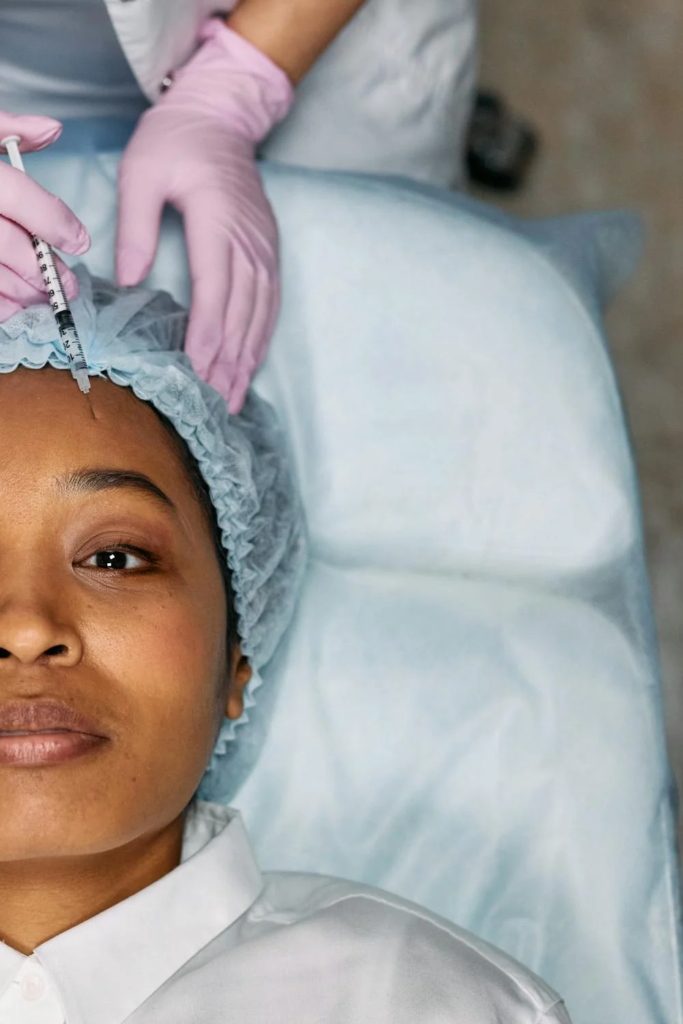Key Takeaways
- Precision Matters: Pinpointing your target audience with precision is essential for effective marketing in the aesthetic industry. Understand their demographics, behaviors, and motivations to tailor your strategies accordingly.
- Personalization Wins: Customizing your messaging and services to meet the unique needs of your target audience fosters stronger connections and drives conversions. Leverage data-driven insights to personalize experiences and stand out in the competitive landscape.
- Continuous Refinement: Defining your target audience is an ongoing process. Regularly monitor performance metrics, adjust strategies based on insights, and stay adaptable to evolving market trends to maintain relevance and drive long-term success.
In the ever-evolving landscape of the aesthetic industry, success isn’t just about offering top-notch services or the latest treatments.
It’s about understanding your audience on a deep level, resonating with their desires, and crafting strategies that speak directly to their needs.
Welcome to our guide on “How to Define Your Target Audience for Aesthetic Clinics” – a roadmap designed to help aesthetic practitioners navigate the complex terrain of customer segmentation, market analysis, and targeted marketing.

In an era where personalization reigns supreme, identifying and understanding your target audience isn’t just a suggestion – it’s a necessity.
Whether you’re a seasoned clinic owner or just starting out, the principles outlined in this guide will empower you to hone in on the demographics, behaviors, and preferences of your ideal clientele, paving the way for sustainable growth and unparalleled success.
Gone are the days of casting a wide net and hoping for the best.
Today’s aesthetic clinics must adopt a laser-focused approach to marketing, one that speaks directly to the individuals most likely to engage with their services.
But before diving into the intricacies of targeted advertising and demographic analysis, it’s essential to grasp the fundamental importance of defining your target audience.
Imagine having a clear understanding of who your ideal clients are – their age, gender, interests, motivations, and even the specific challenges they face when considering aesthetic treatments.
Armed with this knowledge, you can tailor your marketing efforts with precision, creating messaging that resonates deeply and compels action.
But defining your target audience goes beyond demographics alone. It’s about delving into the psyche of your potential clients, understanding their aspirations, fears, and aspirations.
By developing detailed buyer personas, you can humanize your target audience, gaining invaluable insights that inform every aspect of your marketing strategy.
In this guide, we’ll explore the multifaceted process of defining your target audience for aesthetic clinics, from conducting comprehensive market research to leveraging data analytics tools for actionable insights.
We’ll delve into the nuances of creating buyer personas that capture the essence of your ideal clients, and we’ll provide practical tips for refining your marketing strategies to maximize engagement and conversions.
Whether you’re aiming to attract millennials seeking preventative skincare solutions or baby boomers interested in non-invasive anti-aging treatments, this guide will equip you with the knowledge and tools needed to connect with your target audience on a profound level.
So, are you ready to unlock the secrets of successful audience definition and propel your aesthetic clinic to new heights of prosperity?
Let’s dive in.
Before we venture further, we like to share who we are and our digital experiences.
About AppLabx
From developing a solid marketing plan to creating compelling content, optimizing for search engines, leveraging social media, and utilizing paid advertising, AppLabx offers a comprehensive suite of digital marketing services designed to drive growth and profitability for your business.
AppLabx is well known for helping companies and startups use Digital Marketing to drive web traffic to their websites and businesses.
At AppLabx, we understand that no two businesses are alike.
That’s why we take a personalized approach to every project, working closely with our clients to understand their unique needs and goals, and developing customized strategies to help them achieve success.
If you need a digital consultation, then send in an inquiry here.
How to Define Your Target Audience for Aesthetic Clinics
- Understanding the Aesthetic Industry Landscape
- Identifying Your Clinic’s Unique Selling Proposition (USP)
- Conducting Market Research
- Creating Buyer Personas
- Utilizing Data Analytics Tools
- Refining Your Marketing Strategies
- Implementing Targeted Advertising Campaigns
- Monitoring and Adjusting Strategies
1. Understanding the Aesthetic Industry Landscape
In order to effectively define your target audience for aesthetic clinics, it’s essential to have a comprehensive understanding of the industry landscape.
From emerging trends to competitive analysis, this section will delve into the intricacies of the aesthetic industry, providing valuable insights to inform your audience targeting strategies.

Current Trends and Statistics
- Rise in Demand for Non-Invasive Procedures: With advancements in technology and shifting societal attitudes towards beauty and self-care, there has been a significant surge in demand for non-invasive aesthetic procedures. Treatments such as Botox, dermal fillers, and laser skin resurfacing have witnessed exponential growth in recent years.
- Focus on Preventative Skincare: Millennials and younger demographics are increasingly prioritizing preventative skincare measures to maintain youthful, radiant skin and delay the signs of aging. This demographic represents a lucrative market segment for aesthetic clinics offering services such as chemical peels, microdermabrasion, and customized skincare regimens.
- Influence of Social Media and Celebrity Endorsements: The pervasive influence of social media platforms like Instagram, TikTok, and YouTube has reshaped the aesthetic industry landscape. Influencers and celebrities often share their beauty routines and aesthetic treatments, driving consumer interest and shaping beauty ideals.
- Growing Male Market: Traditionally, the aesthetic industry has primarily targeted female clientele. However, there has been a noticeable increase in the number of men seeking aesthetic treatments. Clinics that cater to this demographic by offering specialized services tailored to men’s skincare concerns stand to capitalize on this growing market segment.
Competitive Landscape
- Presence of Established Players: The aesthetic industry is characterized by the presence of established players such as medical spas, dermatology clinics, and plastic surgery practices. These entities often have well-established brand recognition and a loyal customer base.
- Emergence of Niche Clinics: In response to evolving consumer preferences and demands, niche aesthetic clinics specializing in specific treatments or demographics have emerged. For example, there are clinics focusing exclusively on injectables, laser hair removal, or ethnic skincare concerns.
- Innovative Technology and Treatment Modalities: Advancements in technology have led to the development of innovative treatment modalities that offer superior results with minimal downtime. Clinics that stay abreast of these advancements and incorporate them into their service offerings can gain a competitive edge in the market.
- Price Sensitivity and Market Saturation: Price sensitivity remains a key consideration for consumers when choosing aesthetic treatments. Additionally, certain markets may experience saturation, leading to intensified competition among providers. Clinics must differentiate themselves through unique value propositions and targeted marketing strategies.
Importance of Market Research for Aesthetic Clinics
- Identifying Market Opportunities: Conducting thorough market research enables aesthetic clinics to identify untapped market opportunities and niche segments with unmet needs. By understanding market dynamics and consumer preferences, clinics can tailor their services to address specific pain points and differentiate themselves from competitors.
- Informing Strategic Decision-Making: Market research serves as a crucial foundation for strategic decision-making within aesthetic clinics. Whether expanding service offerings, entering new geographical markets, or refining pricing strategies, data-driven insights gleaned from market research inform every aspect of clinic operations.
- Anticipating Industry Shifts: The aesthetic industry is subject to constant evolution, driven by technological advancements, shifting consumer preferences, and regulatory changes. Market research equips clinics with the foresight to anticipate industry shifts and adapt proactively, ensuring long-term viability and competitiveness.
By gaining a nuanced understanding of the aesthetic industry landscape, clinics can position themselves strategically, capitalize on emerging trends, and effectively define their target audience to drive sustainable growth and success.
2. Identifying Your Clinic’s Unique Selling Proposition (USP)
Your clinic’s Unique Selling Proposition (USP) is the cornerstone of your branding and marketing efforts.
It sets you apart from competitors and communicates the value proposition that resonates with your target audience.
In this section, we’ll explore strategies for identifying and leveraging your clinic’s USP to attract and retain clients.

Defining What Sets Your Clinic Apart
- Range of Services: Assess the breadth and depth of services offered by your clinic compared to competitors. Do you specialize in a particular niche or offer a comprehensive range of treatments? Highlight any unique or innovative services that differentiate your clinic from others in the market.
- Expertise and Credentials: Evaluate the qualifications and expertise of your medical staff, including physicians, nurses, and aestheticians. Highlight any specialized training, certifications, or affiliations that demonstrate your clinic’s commitment to excellence and patient safety.
- State-of-the-Art Technology: Identify any cutting-edge technology or equipment used in your clinic that delivers superior results or enhances the patient experience. Whether it’s advanced laser systems, non-invasive body contouring devices, or state-of-the-art skincare technology, emphasize how these technological advancements set your clinic apart.
- Personalized Approach to Care: If your clinic prides itself on providing personalized treatment plans tailored to each patient’s unique needs and goals, this can be a compelling USP. Emphasize your commitment to individualized care and the attentive, personalized service that patients can expect when they choose your clinic.
Understanding the Value Proposition of Your Services
- Quality and Efficacy: Communicate the quality and efficacy of your treatments by highlighting before-and-after photos, patient testimonials, and clinical data demonstrating the effectiveness of your services. Use evidence-based messaging to instill confidence in prospective patients and differentiate your clinic as a trusted provider of aesthetic solutions.
- Safety and Patient Satisfaction: Emphasize your clinic’s commitment to patient safety and satisfaction by highlighting rigorous safety protocols, adherence to industry standards, and high patient satisfaction ratings. Showcase any awards, accreditations, or recognitions received for excellence in patient care and safety.
- Holistic Approach to Wellness: If your clinic takes a holistic approach to beauty and wellness, integrating aesthetic treatments with complementary services such as nutrition counseling, wellness coaching, or stress management programs, this can be a compelling value proposition. Position your clinic as a one-stop destination for comprehensive wellness solutions that address both inner and outer beauty.
Leveraging Your USP to Attract the Right Audience
- Targeted Messaging: Craft your marketing messages to align with your clinic’s USP and resonate with your target audience’s needs and aspirations. Whether it’s emphasizing the luxury experience, the transformative results, or the personalized care, tailor your messaging to highlight the aspects of your USP that are most relevant to your ideal clients.
- Content Marketing Strategies: Create educational content that showcases your clinic’s expertise and reinforces your USP. Blog posts, videos, infographics, and social media posts are valuable tools for educating and engaging your target audience while subtly communicating your clinic’s unique value proposition.
- Strategic Partnerships and Collaborations: Forge partnerships with complementary businesses or influencers whose values align with your clinic’s USP. Collaborative marketing efforts can amplify your reach and credibility while reinforcing your clinic’s unique positioning in the market.
- Consistent Branding: Ensure consistency in branding across all touchpoints, from your website and social media profiles to your clinic’s physical environment and promotional materials. A cohesive brand identity reinforces your USP and cultivates trust and recognition among your target audience.
By carefully identifying and leveraging your clinic’s Unique Selling Proposition, you can differentiate yourself in a crowded market, attract the right audience, and foster long-term loyalty and advocacy among your patients.
3. Conducting Market Research
Market research is a critical component of defining your target audience for aesthetic clinics.
By gathering and analyzing data on market trends, consumer preferences, and competitive dynamics, you can gain valuable insights to inform your audience targeting strategies.

In this section, we’ll explore the various methods and approaches to conducting market research effectively.
Overview of Market Research Methods
- Surveys and Questionnaires: Design and distribute surveys or questionnaires to your current and potential clients to gather insights into their demographics, preferences, and satisfaction levels. Online survey tools like SurveyMonkey or Google Forms make it easy to collect and analyze responses.
- Focus Groups: Organize focus group sessions with a representative sample of your target audience to explore their attitudes, motivations, and perceptions related to aesthetic treatments. This qualitative research method provides valuable qualitative insights that can complement quantitative data.
- Interviews: Conduct one-on-one interviews with key stakeholders, including current patients, former patients, and industry experts, to gain deeper insights into their needs, challenges, and decision-making processes. Semi-structured interviews allow for open-ended exploration of relevant topics.
- Observational Research: Observe consumer behavior and interactions in real-world settings, such as your clinic’s waiting room or reception area. Pay attention to non-verbal cues, interactions with staff, and preferences expressed during consultations to glean valuable insights.
Collecting Demographic Data
- Age and Gender: Gather demographic data on the age and gender distribution of your target audience to understand who is most likely to engage with your aesthetic services. For example, if your clinic specializes in anti-aging treatments, you may find that women aged 35-55 represent a significant portion of your client base.
- Income and Socioeconomic Status: Assess the income levels and socioeconomic status of your target audience to tailor pricing strategies and service offerings accordingly. Higher-income individuals may be more willing to invest in premium aesthetic treatments, while budget-conscious consumers may prioritize cost-effective options.
- Geographic Location: Consider the geographic location of your target audience to identify regional preferences, market trends, and competition dynamics. Urban areas with higher population densities may present greater market opportunities, while rural areas may require targeted outreach efforts to reach potential clients.
Analyzing Psychographic Information
- Lifestyle and Values: Explore the lifestyle choices, values, and beliefs of your target audience to understand their motivations and preferences related to aesthetic treatments. For example, individuals who prioritize holistic wellness may be drawn to clinics that offer natural and organic skincare options.
- Attitudes Towards Beauty: Assess attitudes towards beauty standards, self-image, and aging within your target demographic. Are they seeking to enhance their natural features, reverse signs of aging, or achieve a specific aesthetic ideal? Tailor your messaging and services to align with their desires and aspirations.
- Pain Points and Challenges: Identify the pain points and challenges faced by your target audience when considering aesthetic treatments. Common concerns may include fear of pain, uncertainty about results, or financial constraints. Addressing these concerns in your marketing efforts can alleviate barriers to engagement.
Utilizing Competitor Analysis to Identify Gaps in the Market
- Identify Competitors: Identify direct and indirect competitors in your market, including other aesthetic clinics, medical spas, dermatology practices, and plastic surgery centers. Analyze their service offerings, pricing strategies, marketing tactics, and online presence to understand their strengths and weaknesses.
- SWOT Analysis: Conduct a SWOT (Strengths, Weaknesses, Opportunities, Threats) analysis to assess your clinic’s competitive position relative to rivals. Identify areas where your clinic excels and areas for improvement, as well as potential opportunities for differentiation and growth.
- Identify Market Gaps: Identify gaps or unmet needs in the market that your clinic can address. This could involve offering specialized services not currently available in your area, targeting underserved demographic segments, or leveraging emerging trends to gain a competitive edge.
By conducting comprehensive market research, you can gain valuable insights into your target audience’s demographics, psychographics, and preferences, enabling you to refine your audience targeting strategies and position your clinic for success in the competitive aesthetic industry.
Bonus: Leveraging AppLabx Digital Marketing Agency to Define Your Target Audience for Aesthetic Clinics
At AppLabx Digital Marketing Agency, we specialize in helping aesthetic clinics define and reach their target audience with precision and effectiveness.
Our tailored approach combines data-driven strategies, industry expertise, and innovative techniques to help clinics attract, engage, and retain their ideal clientele.

Here’s how partnering with AppLabx can assist in defining your target audience for aesthetic clinics:
Comprehensive Market Research
- In-Depth Analysis: Our team conducts comprehensive market research to gain insights into industry trends, competitor landscapes, and audience preferences.
- Audience Segmentation: We identify and segment your target audience based on demographics, behaviors, interests, and psychographics, ensuring a nuanced understanding of their needs and preferences.

Persona Development
- Persona Creation: AppLabx creates detailed buyer personas that represent your ideal clients, incorporating demographics, pain points, goals, motivations, and preferred communication channels.
- Personalized Messaging: By understanding the unique characteristics of each persona, we craft personalized messaging and offers that resonate with specific audience segments, increasing relevance and engagement.

Data-Driven Insights
- Utilization of Data Analytics: We leverage advanced data analytics tools and techniques to track and analyze audience behavior, website traffic, and campaign performance.
- Continuous Optimization: Based on data-driven insights, we continuously optimize targeting strategies, messaging, and campaigns to maximize ROI and achieve your marketing objectives.
Targeted Advertising Campaigns
- Strategic Campaign Planning: Our team designs and executes targeted advertising campaigns across various channels, including social media, search engines, and display networks.
- Advanced Targeting Options: We utilize advanced targeting options such as demographic targeting, interest targeting, and retargeting to reach your ideal audience with personalized messaging.

Ongoing Support and Optimization
- Dedicated Account Management: You’ll have access to a dedicated account manager who provides ongoing support, guidance, and optimization recommendations.
- Regular Performance Reporting: We provide transparent and detailed performance reports, allowing you to track progress, measure results, and make informed decisions about your marketing strategies.
Partnering with AppLabx Digital Marketing Agency empowers aesthetic clinics to define their target audience with precision and efficiency, driving sustainable growth, and success in a competitive market landscape.
Let us help you unlock the full potential of your marketing efforts and achieve your business goals.
Send in an inquiry here.
4. Creating Buyer Personas
Buyer personas are fictional representations of your ideal customers based on demographic data, behavioral patterns, motivations, and goals.
By creating detailed buyer personas for your aesthetic clinic, you can better understand and connect with your target audience, tailor your marketing efforts, and improve the effectiveness of your audience targeting strategies.
In this section, we’ll explore the process of creating buyer personas and provide practical tips for crafting personas that resonate with your ideal clientele.
Explanation of Buyer Personas and Their Importance
- Definition: Buyer personas are semi-fictional representations of your ideal customers, based on real data and market research, combined with educated guesses and assumptions about customer demographics, behaviors, and motivations.
- Importance: Buyer personas provide a deeper understanding of your target audience, allowing you to create targeted marketing messages, develop relevant content, and tailor your services to meet the specific needs and preferences of different customer segments.
- Personalization: By creating personalized experiences for different buyer personas, you can increase engagement, build trust, and foster long-term relationships with your target audience. Personalization has been shown to significantly impact conversion rates and customer loyalty.
Step-by-Step Guide to Creating Detailed Buyer Personas
- Gather Data:
- Demographic Information: Collect data on age, gender, income level, occupation, education, and geographic location.
- Behavioral Insights: Analyze customer behaviors such as purchasing habits, online browsing behavior, and engagement with your clinic’s website and social media channels.
- Motivations and Goals: Explore the motivations, goals, aspirations, and pain points of your target audience related to aesthetic treatments.
- Segment Your Audience:
- Identify Common Characteristics: Look for patterns and commonalities among your customer data to segment your audience into distinct groups.
- Prioritize Segments: Prioritize segments based on factors such as size, profitability, growth potential, and alignment with your clinic’s strategic objectives.
- Create Persona Profiles:
- Name and Description: Give each persona a name and create a detailed description that includes demographic information, background, job role, lifestyle, interests, and values.
- Goals and Challenges: Outline the persona’s goals, aspirations, and challenges related to aesthetic treatments, as well as their motivations for seeking out your clinic’s services.
- Preferred Channels and Content: Identify the preferred communication channels and types of content that resonate with each persona, such as social media platforms, email newsletters, or educational blog posts.
- Validate and Refine:
- Feedback from Customers: Seek feedback from existing customers to validate your persona profiles and refine them based on real-world insights.
- Monitor Performance: Continuously monitor the performance of your marketing efforts and adjust your personas as needed based on new data and market trends.
- Example of Buyer Personas:
- Emma, the Career-Driven Professional:
- Demographics: Female, aged 30-45, urban professional, annual income of $80,000-$120,000.
- Goals: Wants to maintain a youthful appearance to stay competitive in her career and boost her confidence.
- Challenges: Limited time for self-care due to demanding job responsibilities, concerns about visible signs of aging.
- Preferred Channels: Active on LinkedIn and Instagram, interested in educational content about non-invasive anti-aging treatments.
- Michael, the Fitness Enthusiast:
- Demographics: Male, aged 25-40, fitness trainer, income level varies.
- Goals: Seeks aesthetic treatments to enhance muscle definition, reduce body fat, and improve overall appearance.
- Challenges: Wants natural-looking results that complement his active lifestyle, concerned about the impact of treatments on his physical performance.
- Preferred Channels: Engages with fitness influencers on social media, interested in content about non-surgical body contouring and skin tightening procedures.
- Sophia, the Bride-to-Be:
- Demographics: Female, aged 25-35, engaged, planning a wedding, annual income of $60,000-$100,000.
- Goals: Wants to look her best on her wedding day, seeking aesthetic treatments to address skincare concerns and enhance her natural beauty.
- Challenges: Limited budget due to wedding expenses, desires visible results with minimal downtime before the wedding.
- Preferred Channels: Actively searches for wedding inspiration on Pinterest and follows bridal influencers on Instagram, interested in content about bridal beauty packages and pre-wedding skincare regimens.
- Emma, the Career-Driven Professional:
By creating detailed buyer personas like Emma, Michael, and Sophia, you can tailor your marketing efforts to address the specific needs, preferences, and aspirations of different segments of your target audience.
This targeted approach enables you to engage with your audience more effectively, drive conversions, and build lasting relationships with your customers.
5. Utilizing Data Analytics Tools
Data analytics tools play a crucial role in understanding audience behavior, tracking marketing performance, and making data-driven decisions to optimize your aesthetic clinic’s marketing strategies.
By harnessing the power of data analytics, you can gain valuable insights into your target audience’s preferences, identify opportunities for improvement, and maximize the effectiveness of your marketing efforts.
In this section, we’ll explore how to utilize data analytics tools effectively to drive success for your aesthetic clinic.

Introduction to Data Analytics Tools
- Definition: Data analytics tools are software platforms or solutions that enable businesses to collect, analyze, and interpret data from various sources to gain actionable insights and inform decision-making.
- Importance: Data analytics tools allow aesthetic clinics to track key metrics, measure marketing performance, identify trends, and understand audience behavior, empowering them to optimize their marketing strategies for maximum impact.
How to Interpret and Use Data to Refine Target Audience Strategies
- Audience Segmentation:
- Demographic Segmentation: Analyze demographic data such as age, gender, income level, and geographic location to identify key segments of your target audience and tailor your marketing efforts accordingly.
- Behavioral Segmentation: Segment your audience based on behavioral data such as browsing behavior, engagement with marketing campaigns, and purchasing habits to understand their preferences and motivations.
- Identifying High-Value Customers:
- Customer Lifetime Value (CLV): Calculate the CLV of your customers to identify high-value segments that contribute the most revenue to your clinic. Focus your marketing efforts on retaining and upselling to these valuable customers.
- RFM Analysis: Conduct RFM (Recency, Frequency, Monetary) analysis to segment customers based on their transactional behavior and prioritize marketing efforts based on their level of engagement and profitability.
- Analyzing Marketing Campaign Performance:
- Website Traffic and Engagement: Use web analytics tools such as Google Analytics to track website traffic, user behavior, and engagement metrics such as bounce rate, time on page, and pages per session. Identify high-performing content and areas for improvement.
- Campaign Attribution: Utilize marketing attribution models to analyze the effectiveness of your marketing campaigns and determine which channels and touchpoints contribute most to conversions. Allocate budget and resources accordingly to maximize ROI.
- Optimizing Content and Messaging:
- A/B Testing: Conduct A/B tests on your website, email campaigns, and digital ads to experiment with different variations of content, messaging, and visuals. Analyze performance metrics to determine which variations resonate best with your audience.
- Sentiment Analysis: Use sentiment analysis tools to analyze customer feedback, reviews, and social media mentions to understand sentiment trends and sentiment drivers. Adjust your messaging and content strategy based on customer sentiment.
- Personalizing Customer Experiences:
- Personalization Platforms: Implement personalization platforms or customer relationship management (CRM) systems to deliver personalized experiences across various touchpoints. Use data-driven insights to tailor content, offers, and recommendations to individual customer preferences.
- Dynamic Content: Leverage dynamic content capabilities to dynamically generate personalized content based on user attributes, behavior, and preferences. Deliver targeted messages and offers that are relevant to each customer’s unique needs and interests.
Case Studies Demonstrating Successful Use of Data Analytics in the Aesthetic Industry
- Clinic A Increases Conversions with A/B Testing:
- Clinic A conducted A/B tests on their website’s landing pages to optimize conversion rates for their skincare consultations.
- By testing different call-to-action buttons, headlines, and images, they were able to identify the most effective combinations and increase conversions by 20%.
- Clinic B Improves Customer Retention with RFM Analysis:
- Clinic B implemented RFM analysis to segment their customer base and identify high-value segments.
- By focusing on personalized communication and loyalty incentives for high-value customers, they increased customer retention by 15%.
- Clinic C Enhances User Experience with Personalization:
- Clinic C implemented a personalization platform to deliver customized content and recommendations to website visitors.
- By tailoring content based on user preferences and behavior, they improved engagement metrics such as time on site and pages per session by 25%.
By leveraging data analytics tools effectively, aesthetic clinics can gain valuable insights into their target audience, optimize marketing strategies, and drive measurable results.
Whether it’s analyzing campaign performance, segmenting audiences, or personalizing customer experiences, data analytics empowers clinics to make informed decisions and achieve their business objectives.
6. Refining Your Marketing Strategies
Refining your marketing strategies is essential for aesthetic clinics to stay competitive in a constantly evolving industry.
By continuously optimizing your approach based on data-driven insights and emerging trends, you can attract and retain customers more effectively, drive conversions, and maximize return on investment (ROI).
In this section, we’ll explore strategies for refining your marketing strategies to achieve optimal results for your aesthetic clinic.
Tailoring Messaging and Visuals to Resonate with Your Target Audience
- Audience Segmentation: Utilize the buyer personas and audience segmentation data generated from your market research to tailor your messaging and visuals to resonate with different segments of your target audience.
- Address Pain Points: Identify and address the pain points, aspirations, and motivations of your target audience in your marketing messaging. Highlight how your clinic’s services can solve their problems and fulfill their desires.
- Use Emotional Appeals: Incorporate emotional appeals into your messaging and visuals to evoke empathy, desire, or urgency. For example, emphasize the emotional benefits of aesthetic treatments such as increased confidence, improved self-esteem, and enhanced quality of life.
Choosing the Most Effective Marketing Channels for Reaching Your Audience
- Multi-Channel Approach: Adopt a multi-channel marketing approach to reach your target audience across various touchpoints, including digital channels (e.g., website, social media, email) and offline channels (e.g., print ads, direct mail).
- Data-Driven Decisions: Use data analytics tools to analyze the performance of different marketing channels and campaigns. Allocate budget and resources to channels that drive the highest engagement, conversions, and ROI.
- Test and Iterate: Experiment with different marketing channels and tactics to identify the most effective strategies for reaching your target audience. Continuously test and iterate based on performance data to optimize your marketing mix.
Tips for Creating Engaging Content that Appeals to Your Target Demographic
- Educational Content: Create educational content that addresses common questions, concerns, and misconceptions related to aesthetic treatments. For example, publish blog posts, videos, or infographics explaining different procedures, benefits, and risks.
- User-Generated Content: Encourage satisfied customers to share their experiences and results on social media platforms. User-generated content adds authenticity and credibility to your marketing efforts and can attract new customers through word-of-mouth referrals.
- Visual Content: Use high-quality visuals, including before-and-after photos, videos, and infographics, to showcase your clinic’s services and results. Visual content is more engaging and memorable than text alone and can help drive conversions.
Implementing Targeted Advertising Campaigns
- Audience Targeting: Utilize advanced targeting options available on digital advertising platforms such as Facebook Ads and Google Ads to reach specific segments of your target audience based on demographics, interests, and behavior.
- Ad Personalization: Tailor your ad creatives and messaging to resonate with different segments of your target audience. Use dynamic ad elements such as personalized recommendations, testimonials, and offers to increase relevance and engagement.
- Conversion Tracking: Implement conversion tracking on your advertising campaigns to measure the effectiveness of your ads in driving desired actions, such as website visits, form submissions, or appointment bookings. Use conversion data to optimize your ad targeting and messaging for maximum impact.
Best Practices for Optimizing Website Performance and User Experience
- Mobile Optimization: Ensure your website is fully optimized for mobile devices to provide a seamless browsing experience for mobile users. Mobile optimization improves user satisfaction, reduces bounce rates, and enhances search engine rankings.
- Fast Loading Times: Optimize your website’s loading speed to minimize bounce rates and improve user experience. Compress images, minimize server response times, and leverage browser caching to speed up page load times.
- Clear Call-to-Action (CTA): Use clear and compelling calls-to-action (CTAs) throughout your website to guide visitors towards desired actions, such as scheduling a consultation or requesting more information. Make CTAs prominent, visually appealing, and easy to click.
Case Studies Demonstrating Successful Marketing Strategy Refinements
- Clinic A Increases Conversion Rates with Personalized Email Campaigns:
- Clinic A implemented personalized email campaigns targeting specific segments of their audience based on their interests and behavior.
- By tailoring content and offers to each segment’s preferences, they increased email open rates by 30% and conversion rates by 20%.
- Clinic B Improves ROI with Targeted Facebook Ads:
- Clinic B launched targeted Facebook ads promoting their new skincare line to female customers aged 25-45 interested in skincare and beauty.
- By refining their ad targeting and creative elements based on audience insights, they achieved a 2x increase in return on ad spend (ROAS) compared to previous campaigns.
- Clinic C Enhances User Experience with Website Optimization:
- Clinic C optimized their website for mobile devices and improved loading speed to provide a better user experience for mobile users.
- As a result, they saw a 40% decrease in bounce rates and a 25% increase in conversions from mobile traffic within the first month of implementation.
By refining your marketing strategies based on data-driven insights and best practices, you can effectively engage your target audience, drive conversions, and achieve your business objectives in the competitive aesthetic industry.
7. Implementing Targeted Advertising Campaigns
Implementing targeted advertising campaigns is a strategic approach to reaching your ideal audience with personalized messaging and offers.
By leveraging advanced targeting options available on digital advertising platforms, such as Facebook Ads and Google Ads, aesthetic clinics can maximize the effectiveness of their advertising efforts and drive relevant traffic to their website or clinic.
In this section, we’ll explore strategies for implementing targeted advertising campaigns and achieving optimal results for your aesthetic clinic.
Leveraging Advanced Targeting Options
- Demographic Targeting: Target your ads based on demographic criteria such as age, gender, income level, education level, and marital status. This allows you to tailor your messaging to specific segments of your target audience.
- Interest Targeting: Reach users who have expressed interest in relevant topics, products, or services related to aesthetic treatments. Utilize interest targeting options to target users based on their interests, hobbies, and online behavior.
- Behavioral Targeting: Target users based on their online behavior and interactions, such as website visits, search history, and engagement with specific content. Behavioral targeting allows you to reach users who are actively researching or expressing interest in aesthetic treatments.
- Custom Audience Targeting: Create custom audiences based on your existing customer data, such as email lists, website visitors, or past purchasers. Use custom audience targeting to re-engage past customers or target users similar to your existing customer base through lookalike audience targeting.
- Geographic Targeting: Target users based on their geographic location, including countries, regions, cities, or specific zip codes. Geographic targeting allows you to focus your advertising efforts on locations where your target audience is most concentrated or where there is high demand for aesthetic treatments.
Tailoring Ad Creatives and Messaging
- Personalization: Personalize your ad creatives and messaging to resonate with your target audience’s preferences, interests, and pain points. Use dynamic ad elements such as personalized recommendations, testimonials, and offers to increase relevance and engagement.
- Compelling Visuals: Use high-quality images and videos in your ad creatives to capture attention and convey the benefits of your aesthetic treatments effectively. Showcase before-and-after photos, client testimonials, or visual representations of your clinic’s services to drive interest and engagement.
- Clear Call-to-Action (CTA): Include a clear and compelling call-to-action (CTA) in your ad creatives to prompt users to take the desired action, such as scheduling a consultation, requesting more information, or visiting your clinic’s website. Make the CTA prominent, actionable, and aligned with the ad objective.
Setting Campaign Objectives and Key Performance Indicators (KPIs)
- Objective Alignment: Align your campaign objectives with your clinic’s overall marketing goals, whether it’s increasing brand awareness, driving website traffic, generating leads, or driving conversions. Define clear objectives to guide your campaign strategy and measurement.
- Key Performance Indicators (KPIs): Define key performance indicators (KPIs) to measure the success of your advertising campaigns. KPIs may include metrics such as click-through rate (CTR), conversion rate, cost per acquisition (CPA), return on ad spend (ROAS), and customer lifetime value (CLV).
- SMART Goals: Set SMART (Specific, Measurable, Achievable, Relevant, Time-bound) goals for your advertising campaigns to ensure clarity and accountability. Establish realistic targets for each KPI based on historical performance, industry benchmarks, and campaign objectives.
Optimizing Ad Performance and Budget Allocation
- Continuous Monitoring: Monitor the performance of your advertising campaigns regularly to identify areas for improvement and optimization. Track key metrics, such as CTR, conversion rate, and ROAS, and compare performance against your predefined KPIs.
- A/B Testing: Conduct A/B tests on different ad creatives, messaging, targeting options, and landing pages to identify the most effective combinations. Test variables systematically and iterate based on performance data to optimize campaign performance.
- Budget Allocation: Allocate your advertising budget strategically based on the performance of individual campaigns, ad sets, and targeting options. Shift budget towards high-performing campaigns and audiences while pausing or adjusting underperforming ones to maximize ROI.
Case Studies Demonstrating Successful Implementation of Targeted Advertising Campaigns
- Clinic A Increases Consultation Bookings with Facebook Ads:
- Clinic A launched targeted Facebook ads promoting their free skincare consultation offer to women aged 25-45 in their local area.
- By leveraging interest targeting options related to skincare and beauty, they increased consultation bookings by 50% within the first month of the campaign.
- Clinic B Drives Conversions with Google Ads:
- Clinic B implemented Google Ads campaigns targeting users searching for specific aesthetic treatments, such as “Botox injections” and “lip fillers”.
- By optimizing ad copy and bidding strategies based on keyword performance, they achieved a 30% increase in conversion rate and a 20% decrease in cost per acquisition (CPA) compared to previous campaigns.
- Clinic C Boosts Brand Awareness with Instagram Stories Ads:
- Clinic C ran Instagram Stories ads featuring engaging visuals and testimonials from satisfied customers to raise awareness of their non-invasive body contouring services.
- By targeting users aged 25-35 interested in fitness and wellness, they reached over 100,000 impressions and generated a 15% increase in website visits from Instagram.
By implementing targeted advertising campaigns effectively, aesthetic clinics can reach their ideal audience with personalized messaging, drive relevant traffic and conversions, and achieve their marketing objectives in a cost-effective manner.
8. Monitoring and Adjusting Strategies
Monitoring and adjusting marketing strategies is a crucial aspect of ensuring ongoing success and effectiveness for aesthetic clinics.
By regularly analyzing key metrics, tracking campaign performance, and adapting strategies based on data-driven insights, clinics can optimize their marketing efforts, maximize ROI, and stay ahead of the competition.
In this section, we’ll explore strategies for monitoring and adjusting marketing strategies to achieve optimal results for your aesthetic clinic.
Establishing Key Performance Indicators (KPIs)
- Define Clear Objectives: Establish clear objectives for your marketing efforts, whether it’s increasing brand awareness, driving website traffic, generating leads, or boosting conversions.
- Identify Relevant Metrics: Determine which key performance indicators (KPIs) are most relevant to your objectives and clinic’s goals. Common KPIs for aesthetic clinics may include website traffic, conversion rate, cost per lead, customer acquisition cost, and return on investment (ROI).
- Set SMART Goals: Ensure your KPIs are Specific, Measurable, Achievable, Relevant, and Time-bound (SMART). Establish specific targets and timelines for each KPI to guide your monitoring and adjustment efforts.
Utilizing Data Analytics Tools for Performance Tracking
- Implement Tracking Mechanisms: Set up tracking mechanisms using data analytics tools such as Google Analytics, Facebook Insights, and CRM systems to monitor key metrics and performance indicators.
- Track Website Traffic: Monitor website traffic metrics such as sessions, pageviews, bounce rate, and average session duration to assess the effectiveness of your website in attracting and engaging visitors.
- Monitor Conversion Funnel: Track conversion metrics at each stage of the conversion funnel, from initial website visits to lead generation and appointment bookings. Identify areas of drop-off and opportunities for optimization.
Analyzing Campaign Performance and Audience Insights
- Campaign Analysis: Regularly analyze the performance of your marketing campaigns across different channels and platforms. Assess key metrics such as click-through rate (CTR), conversion rate, cost per conversion, and return on ad spend (ROAS).
- Audience Insights: Dive deep into audience insights to understand the demographics, behaviors, and preferences of your target audience. Identify patterns and trends that can inform future targeting and messaging strategies.
- Competitor Analysis: Monitor competitors’ marketing activities and performance to benchmark your clinic’s performance against industry standards and identify areas of competitive advantage or opportunity.
Identifying Opportunities for Optimization and Improvement
- Identify Underperforming Areas: Identify underperforming campaigns, ad sets, targeting options, or website pages that are not meeting your predefined KPIs. Look for areas of inefficiency or missed opportunities for improvement.
- A/B Testing: Conduct A/B tests to experiment with different variations of your marketing assets, messaging, and targeting options. Test variables systematically and analyze performance data to identify winning strategies.
- Continuous Improvement: Embrace a culture of continuous improvement by iteratively optimizing your marketing strategies based on performance data and insights. Stay agile and adaptable in response to changes in the market or consumer behavior.
Making Informed Adjustments and Iterations
- Data-Driven Decision Making: Base adjustments and iterations on data-driven insights rather than assumptions or intuition. Let performance data guide your decision-making process and prioritize strategies that demonstrate the greatest impact.
- Iterative Approach: Take an iterative approach to strategy adjustments, making incremental changes based on performance trends and feedback. Monitor the effects of adjustments closely and be prepared to course-correct as needed.
- Experimentation and Innovation: Foster a culture of experimentation and innovation within your marketing team, encouraging the testing of new ideas, tactics, and channels. Embrace a willingness to take calculated risks and learn from both successes and failures.
Case Studies Demonstrating Successful Monitoring and Adjustment Strategies
- Clinic A Increases Website Conversions with A/B Testing:
- Clinic A conducted A/B tests on their website’s appointment booking form, testing different form layouts, field labels, and call-to-action buttons.
- By identifying the highest-performing combination, they increased website conversion rates by 25% and improved the user experience for visitors.
- Clinic B Optimizes Facebook Ad Campaigns Based on Audience Insights:
- Clinic B analyzed audience insights from their Facebook ad campaigns and identified a high-performing segment of female users aged 35-55 interested in anti-aging treatments.
- By reallocating budget towards this audience segment and refining ad messaging to address their specific concerns, they achieved a 30% increase in conversion rate and a 20% decrease in cost per acquisition.
- Clinic C Adapts Messaging Strategy Based on Competitive Analysis:
- Clinic C conducted a competitive analysis of local aesthetic clinics and identified a gap in the market for non-invasive body contouring treatments targeting postpartum women.
- By adjusting their messaging to emphasize the benefits of their body contouring services for postpartum recovery, they attracted a new segment of customers and increased consultation bookings by 40%.
By monitoring performance metrics, analyzing audience insights, and making data-driven adjustments, aesthetic clinics can optimize their marketing strategies for maximum effectiveness, drive results, and achieve their business objectives in a competitive market landscape.
Conclusion
Understanding and defining your target audience for aesthetic clinics is a fundamental aspect of successful marketing strategy.
By identifying and connecting with the right audience segments, clinics can effectively tailor their services, messaging, and marketing efforts to meet the specific needs and preferences of their clientele.
Throughout this guide, we’ve explored a comprehensive framework for defining your target audience, including conducting market research, creating buyer personas, and implementing targeted advertising campaigns.
From analyzing market trends and competitor landscapes to segmenting audiences and crafting personalized messaging, each step in the process is essential for gaining valuable insights and maximizing the impact of your marketing initiatives.
By leveraging data analytics tools, clinics can monitor performance metrics, track campaign effectiveness, and make informed adjustments to optimize their strategies over time.
Furthermore, adopting a customer-centric approach and continuously refining strategies based on audience feedback and market dynamics is key to staying competitive and achieving long-term success in the aesthetic industry.
Remember, defining your target audience is not a one-time task but an ongoing process that requires regular evaluation, adaptation, and innovation. By staying attuned to the evolving needs and preferences of your audience, aesthetic clinics can build stronger relationships, drive conversions, and ultimately thrive in a highly competitive market environment.
In essence, the journey to defining your target audience is a strategic investment that lays the foundation for sustainable growth, profitability, and differentiation in the aesthetic industry.
With a deep understanding of your audience’s demographics, psychographics, and preferences, you can position your clinic as the go-to destination for personalized, high-quality aesthetic treatments that resonate with your ideal clientele.
If you are looking for a top-class digital marketer, then book a free consultation slot here.
If you find this article useful, why not share it with your friends and business partners, and also leave a nice comment below?
We, at the AppLabx Research Team, strive to bring the latest and most meaningful data, guides, and statistics to your doorstep.
To get access to top-quality guides, click over to the AppLabx Blog.
People also ask
How can I define the target audience for my aesthetic clinic?
Identify key demographics, behaviors, and motivations of potential clients through market research and data analysis.
What role do buyer personas play in defining the target audience?
Buyer personas represent ideal clients and help personalize marketing efforts by understanding their needs and preferences.
How can market research help in defining the target audience?
Market research provides valuable insights into industry trends, competitor landscapes, and audience preferences to inform targeting strategies.
What are the benefits of segmenting the target audience?
Segmenting the target audience allows clinics to tailor marketing messages and services to specific groups, increasing relevance and engagement.
What are some common demographic factors to consider when defining the target audience?
Age, gender, income level, education, occupation, and geographic location are common demographic factors to consider.
How can I gather demographic data about my target audience?
Utilize surveys, questionnaires, customer interviews, and data analytics tools to collect demographic information from existing and potential clients.
What is behavioral segmentation, and why is it important?
Behavioral segmentation categorizes the target audience based on their actions, such as purchasing behavior, online engagement, and lifestyle choices, providing insights into their preferences and habits.
How can I leverage behavioral data to define the target audience?
Analyze customer interactions, website traffic patterns, and social media engagement metrics to identify behavioral trends and tailor marketing strategies accordingly.
What are the key components of creating effective buyer personas?
Effective buyer personas include detailed descriptions of demographics, behaviors, motivations, goals, challenges, and preferred communication channels.
How can I validate the accuracy of my buyer personas?
Validate buyer personas by collecting feedback from existing customers, conducting surveys, and analyzing real-world data to ensure alignment with actual audience characteristics.
What are some common mistakes to avoid when defining the target audience?
Avoid generalizing your audience, neglecting to update personas regularly, and relying solely on assumptions without data-backed insights.
How can I use data analytics tools to define the target audience?
Data analytics tools provide valuable insights into audience behavior, allowing clinics to track website traffic, measure campaign performance, and identify audience segments for targeting.
What role does personalization play in defining the target audience?
Personalization allows clinics to tailor marketing messages, services, and experiences to individual audience segments, increasing relevance and engagement.
How can I optimize my website to attract and engage the target audience?
Optimize website content, design, and user experience to cater to the needs and preferences of the target audience, making it easy to navigate and find relevant information.
What are some effective strategies for engaging with the target audience on social media?
Post relevant content, interact with followers, participate in conversations, and run targeted advertising campaigns to engage with the target audience on social media platforms.
How can I refine my marketing strategies based on audience feedback?
Collect feedback through surveys, reviews, and social media interactions, and use insights to adjust messaging, offerings, and marketing tactics to better resonate with the target audience.
What role does competitor analysis play in defining the target audience?
Competitor analysis helps clinics understand industry trends, identify gaps in the market, and differentiate themselves by catering to unmet needs of the target audience.
How can I adapt my marketing strategies to changing audience preferences?
Stay agile and responsive to changing audience preferences by regularly monitoring trends, experimenting with new tactics, and soliciting feedback from customers.
What are some effective ways to measure the effectiveness of marketing campaigns?
Track key performance indicators (KPIs) such as website traffic, conversion rates, cost per acquisition (CPA), and return on investment (ROI) to gauge the effectiveness of marketing campaigns.
How can I adjust my targeting strategies to reach new audience segments?
Explore new demographics, behaviors, and interests to expand your reach and attract new audience segments. Test different targeting options and monitor performance to optimize results.
How can I leverage content marketing to attract and engage the target audience?
Create informative and engaging content that addresses the needs, interests, and concerns of the target audience. Distribute content through various channels to attract and engage potential clients.
What are some effective ways to communicate with the target audience?
Use a mix of channels such as email marketing, social media, website content, and offline advertising to communicate with the target audience. Tailor messaging to resonate with their preferences and interests.
How can I ensure my marketing efforts are compliant with regulations in the aesthetic industry?
Stay informed about industry regulations and guidelines related to advertising, marketing, and data privacy. Ensure all marketing materials adhere to legal requirements and ethical standards.
What are some strategies for retaining and nurturing relationships with the target audience?
Provide exceptional customer service, offer loyalty programs and incentives, and maintain regular communication to build trust and loyalty with the target audience.
How can I measure the lifetime value of my customers?
Calculate customer lifetime value (CLV) by analyzing historical data on customer purchases, average order value, and retention rates. Use CLV to inform marketing strategies and customer acquisition efforts.
How can I leverage customer feedback to improve services and offerings?
Solicit feedback through surveys, reviews, and direct communication with customers. Use insights to identify areas for improvement, refine services, and enhance the customer experience.
What role does brand positioning play in defining the target audience?
Brand positioning helps clinics differentiate themselves in the market and attract the attention of the target audience by communicating unique value propositions and brand attributes.




































